I have long advocated the practice of stockpiling ammunition. Today I’m going to attempt (again) to encourage you to purchase ammunition at your leisure rather than in knee-jerk response to external stimuli.
This article contains affiliate links.
A Quick Word on Reloading
The last time I wrote an article of this nature I was informed that building an ammunition stockpile was unnecessary for those who practice reloading. I have nothing against reloading at all. In fact I have a bunch of buckets of brass in the garage and I may well take it up one of these days, just for fun. While I get it – you can make your own ammo – I believe that statement misses the forest for the trees.
The reloader isn’t relieved from stockpiling. The reloader’s burden shifts from purchasing loaded ammunition to purchasing ammunition components. Your reloading bench does little good without an adequate supply of brass, bullets, powder, and primers. I have seen components in high demand and low supply in the past and those shortages will probably happen again (if they aren’t already). If your primary mechanism for stockpiling ammunition is reloading, you should substitute (almost) every instance of the word “ammunition” in this article with the word “components.”
Why You Should Have an Ammunition Stockpile
Most people assume that things will mostly be good, mostly forever. It is very difficult to get people to imagine and prepare for uncommon events. It is even difficult to get people to prepare for relatively common events, or events that have very high likelihood of occurrence, like earthquakes and tornadoes. And apparently, during good times it is really, really difficult to get people to realize that ammunition won’t always be freely available and dirt cheap – despite us all having experienced wild price spikes and limited availability.
The single most important thing you can do to begin creating an ammunition stockpile is realize that bad things happen. Regardless of your religious, political, or ideological stance, there is some possible negative outcome that doesn’t challenge your beliefs that could impact your ability to purchase ammunition in the future. It may be that ammunition becomes really difficult to find, subject to licenses or permits, or just insanely expensive. Any of these could mean you absolutely cannot get ammunition when you really, really need it.
Here is the thing that really gets me: every gun owner KNOWS that every few years something will happen that makes ammunition a highly valued commodity. ammunition will become expensive. People will be begin to panic-buy and it will become difficult to obtain from your usual sources. You will likely have a hard time finding the ammunition you want. With that being a virtual guarantee, why on Earth wouldn’t you stock some ammo when it is cheap? If you still need a reason, here are a few.
First, there are a number of things that might keep you from getting to the store when you need some ammo. Riots in the streets or a pandemic are just two far-fetched scenarios I can imagine. Floods, hurricanes, earthquakes, wildfires, tornadoes, are just a few of the things that might keep you from getting to the store, keep the store from opening, or destroy the entire town where the store is.
Secondly, ammunition can become insanely expensive. It is one of those products that is extremely sensitive to fear/panic-buying. Probably the most predictable event driving huge price-spikes and unavailability is politics. It’s no secret when the next election is, or the one after that, or the one after that. If the tribe that you don’t like wins, ammunition will become more expensive and less available. Even if the election is contentious and a close call, ammunition will become more expensive and less available. These are not unpredictable, one-off events. Plan ahead.
Ammunition Stockpile: Defensive Ammunition
First and foremost I think you should develop a solid reserve of defensive ammunition. I’ve seen some differing opinions on this, and the logic usually goes something along the lines of avoidance of gunfights (or low survivability if you start to get into a lot of them). That part of the logic is 100% spot-on – I don’t expect or want to be in any gunfights, let alone enough to use hundreds of rounds of ammunition.
Ammunition, however, doesn’t last forever. It gets beat up on chambering and ejecting. Even if you just carry it, it is exposed to vibration, moisture, oils/solvents, and temperature fluctuations. If you spend a lot of time outdoors it gets rained on, sweated on (moisture and salt), and your magazines and cylinders end up full of fine, abrasive dust. Even the most attentive gun owner will occasionally run a magazine or stripper clip of ammo through the washing machine.
As I pointed out recently, I go through about 100 rounds of defensive ammo per year just cycling ammo in and out of my carry gun for dry practice and range sessions. At that rate a case of 1,000 rounds would only last about 10 years – well within the limits how long the ammo would be “good” for if stored properly (and I am operating with an extreme abundance of caution). Ten years sounds like a long, long time but it’s not very long at all if bans make ammunition completely unavailable in the future.
If I absolutely couldn’t get any more defensive ammunition I could make 1,000 rounds go much, much further than that. In fact, I could (and would) use it judiciously and make it easily last the rest of my life. Does that mean I recommend 10,000 rounds of high-end premium ammo? No, but I sure wouldn’t want to be stuck with just two loaded magazines and half a box in the safe. How confident would I feel be in that ammunition after carrying it for five years? Six? Seven?
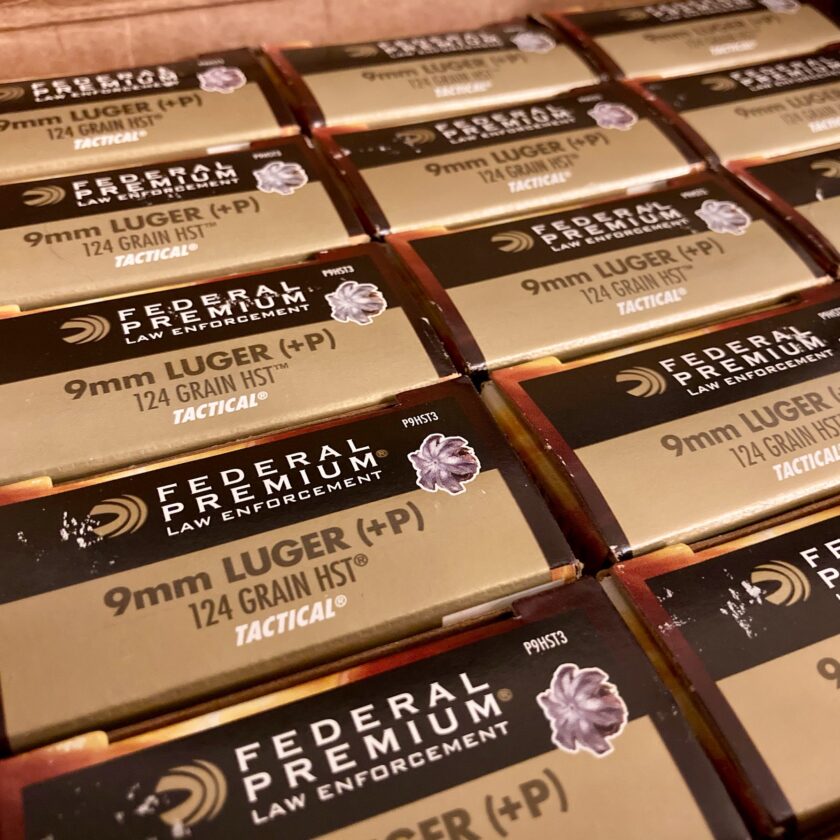
Now, you could definitely switch to ball ammo that is newer, cleaner, and less abused. My problem with that is that most ball ammo is made to a relatively low standard with cheaper components. Everything – not just the bullet – is typically of a lower quality. Would I turn up my nose at it if it’s all I had? Of course not, but if I wouldn’t carry it on the day-to-day now, I would prefer not to be stuck with it when things are perhaps more sporting. I would much prefer to carry premium ammunition, and not just because of the whiz-bang hollowpoint at the pointy end.
If you are still unmoved, I believe there is a more pragmatic reason to have some defensive ammunition laid in. Some loads shoot very well in a certain gun, while some do not (I’m thinking of those of you that like the Federal Flite-Control shotgun ammunition here). Some loads are regulated to a particular gun’s sights and some are not (I’m specifically thinking of non-adjustable handgun sights here). Certain loads are reliable in certain guns and others are not (I’m thinking of a handgun that I own that runs magically with Speer Gold Dots, but is finicky with the Federal load that already own a ton of).
When I find something that my gun likes and that has proven reliable, I try to stick with it. I hate having to scrounge around to find that certain SKU that runs well in my gun. Even during the best of times locating a certain defensive load, in a certain bullet weight, in +P or not, isn’t the easiest thing. I’d prefer to buy a good quantity up front and not worry about it for at least ten years or so.
Defensive Ammunition Quantities
I don’t believe it’s as easy to put a number on this as you might imagine. Nice, round numbers like 1,000 or 10,000 seem to make people really happy, but let’s talk this through. Please keep in mind these numbers are just my opinion. They aren’t based in science or unassailable fact or anything else. If you don’t like them throw them out and come up with your own numbers.
First, I believe your use-case should indicate how much ammunition you decide to lay in. If your firearm is a daily-carry handgun, you will want a good, solid supply of defensive ammunition. That is where I assume that most people who actually read this will fall. I believe this because – again – ammunition degrades over time. Even if you never unload your pistol, ammunition still degrades. Being exposed to constant vibration can have a deleterious effect on primers. Being on your body exposes the ammunition to heat and water vapor. If you do unload and reload your gun occasionally… well, you see where I’m going.
For handguns that you carry or load/unload frequently I think that 500 rounds of defensive ammunition is a prudent minimum quantity. Above all it should be ammunition that is confirmed reliable in your handgun. It should also shoot accurately and have an appropriate point of impact relative to your sights. Remember, as I mentioned before: high-quality isn’t just about the fancy bullet in the end of that cartridge. It is also about high-quality powder, primers, waterproofing, quality control, etc.
For handguns that you don’t carry or use heavily, I believe you can get by with significantly less. If you have an old pistol that sits in a drawer waiting for the day you need it, you are putting very little stress on your ammunition. I would imagine – if you leave it alone – that ammunition will be good more or less indefinitely assuming it doesn’t get insanely hot, cold, or humid in your house. In that case I think you should have a minimum of 100 to 150 rounds of high-quality ammunition that functions reliably in your handgun and has a coinciding point-of-aim/point-of-impact.
If your handgun is a revolver it matters less if you load/unload a lot or not. Loading and unloading is much less stressful on ammunition than in a semi-auto gun. There is no massive force pounding the cartridge into the chamber, which means an almost zero chance of bullet setback, and a very low chance of damage to the primer. An extractor isn’t applying large amounts of force to the rim of the case, and a slide isn’t cycling over the top of one cartridge over and over again. Rather than swapping out revolver carry ammo based on how often I’ve loaded/unloaded it, I change out this ammo on a time-basis of once every six months.
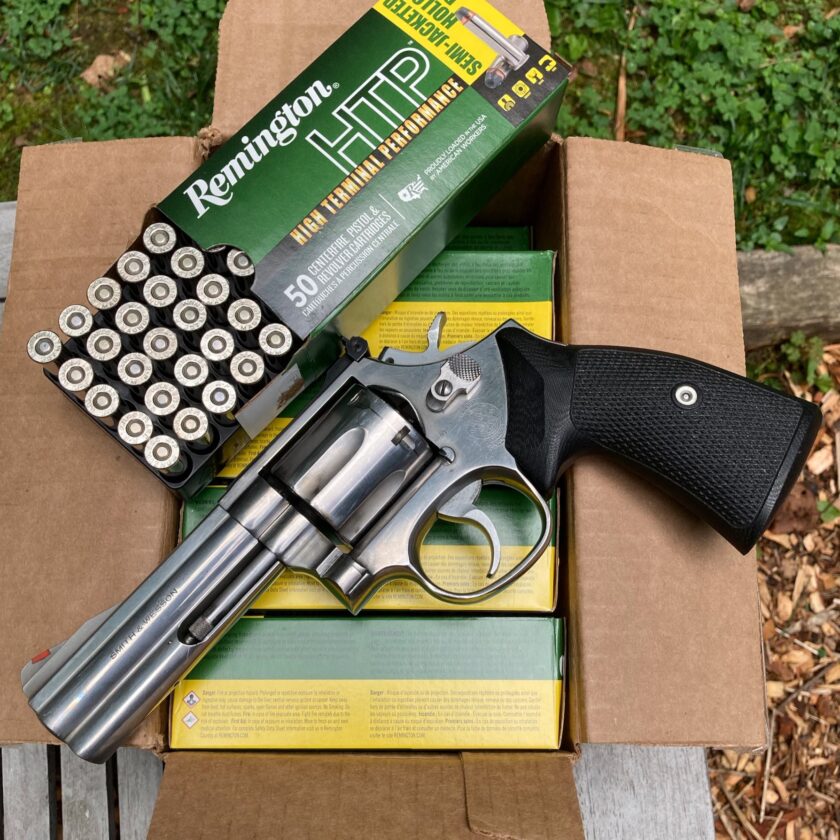
Revolvers do pose some interesting challenges. Crucially, .38 Special ammunition and .357 Magnum ammunition runs anywhere from 30 to 50 percent more expensive than 9mm. Even 10mm – the poster child for expensive, boutique caliber ammunition – is usually cheaper than .38 Special. Secondly, it can be really, really hard to find 50-round boxes of high-end defensive ammo for revolvers (not impossible, but really difficult). Fortunately, you can sometimes find an ammo that will do double duty, like the Remington HTP 110-grain JHPs above. They are cheap enough that I shoot quite a few of them, but I would also be OK loading them up for carry.
For your rifles and shotguns I believe 250 rounds of your preferred defensive and/or hunting ammunition is a good starting point. These weapons are not likely to get carried, loaded, and unloaded nearly as much as your handguns. They are also pretty likely to stay indoors most of the time. This ammunition may be no less critical, but it is generally probably exposed to less abuse. A couple hundred gives you enough to confirm your pattern/zero occasionally, replace ammo that has been in the field, etc.
Ammunition Stockpile: Practice Ammunition
You should absolutely have a good supply of practice ammunition. My primary reasoning here is to insulate myself from wild price fluctuations. We have created an emotionally-driven firearms market. Rather than panic while prices and demand are high, and supply and variety is low, I do most of my purchasing when the majority of firearms consumers are primarily influenced by low-arousal emotions – i.e., they aren’t panic-buying every box of ammo out there.
Practice ammo forms the basis of my ammunition stockpile. It makes up the largest quantities of ammunition I possess. It is also in a frequent in/out rotation, and because of this I handle it a lot. I also spend a great deal of time thinking about, about how much I have, and how much I think you should have.
For the average individual, I think purchasing a case of 1,000 rounds of you preferred handgun ammunition is a very good starting point. I recommend replacing everything you shoot out of that case, and maintaining a minimum of 1,000 rounds. Why 1,000? With some instruction and some dry practice you can get pretty good on 1,000 rounds. With a lot of dry practice you can get insanely good with 500 rounds and maintain it for a long, long time with the other 500. I think 1,000 is an awesome starting point.
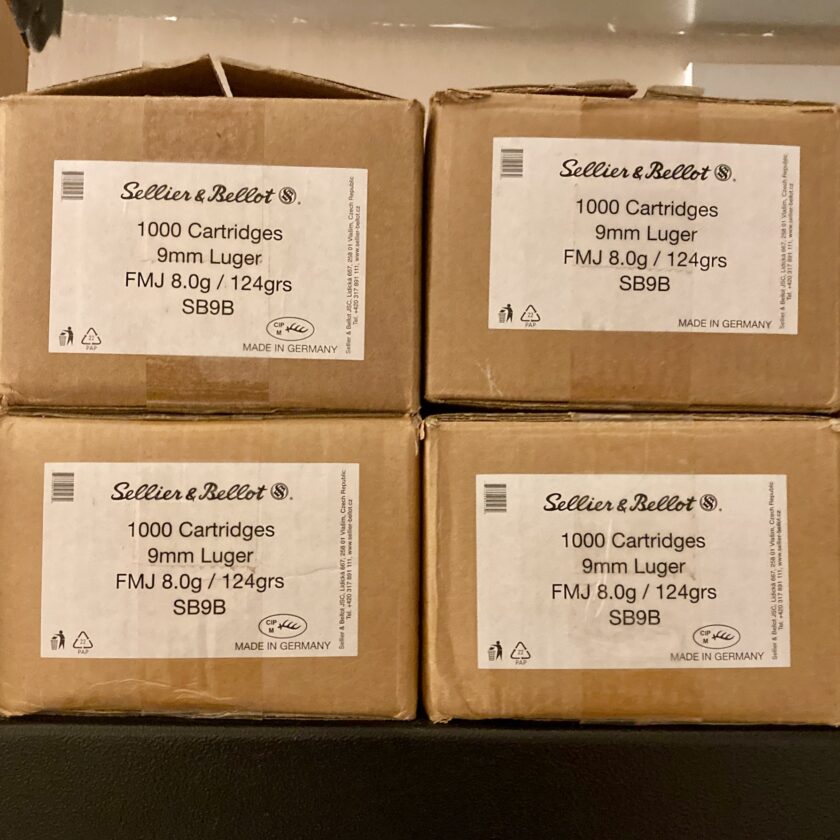
For the heavy/serious shooters, I recommend an aspirational goal developing a lifetime supply of ammunition. I’ll be honest, I’m stealing this directly from Greg Ellifritz. It is never something I had considered, but I am 100% in favor of it. Rather, I operated on a system of minimums, i.e., “I never want to drop below 5,000 rounds of 9mm.” I like the system of minimums because that 5,000 rounds of 9mm would let me shoot 100 rounds a quarter for twelve and a half years. Coupled with daily dry practice I could still be at the top of my game on that relatively small amount of ammo.
The lifetime supply idea just takes the concept a bit further. For example, I may want to continue shooting at the same rate for another 40 years. One hundred rounds per quarter, times forty years, times four quarters equals 16,000 rounds of 9mm – honestly a pretty manageable number. Anything on top of that would allow me to increase my quarterly minimum, or enjoy some long range sessions here and there.Obviously I’m focusing on handguns, and you also want to plan for your rifles and shotguns.
One other aspect for me is teaching others to shoot. In addition to maintaining my own skill, I would want to pad whatever my number is with maybe two thousand rounds, times two shooters. I could make each shooter pretty damn good with 1,000 rounds. He or she could maintain that skill enough to develop some decent myelinization on the next thousand. I’m not sure who that person would be, but passing on some knowledge is pretty important to me.
How to Build an Ammunition Stockpile
Acquiring an ammunition stockpile isn’t actually all that difficult or complicated. It requires nothing more than purchasing more ammunition than you consume and storing it safely.
Buying a lot at a time is as simple as ordering ammo by the case. In most states you can purchase ammo by the case from a number of companies. I have bought many cases from SGAmmo.com. I have no financial relationship with them at all, other than giving them a lot of money over the years. I mention them only because they are typically the cheapest source of ammunition, often have the best selection, and their shipping is superb. Buying ammunition by the case has some big benefits. It is very easy to accumulate a large supply of ammunition fairly quickly.
Most importantly, it is nearly always significantly cheaper than paying retail. The downside is a case of ammo will require some investment up-front. At the time of writing a case of 9mm runs a little under $300. I realize that’s difficult to do for some people.
Of note – and just so it’s clear that I’m not biased – a credit card I used at SGAmmo.com was stolen. I’m not accusing SGAmmo of losing my info, but my security game is pretty tight. I would strongly recommend using a virtual, merchant-bound credit card, like those from Privacy.com for ALL your online shopping, including your ammo shopping. Still I have no problem recommending SGAmmo.
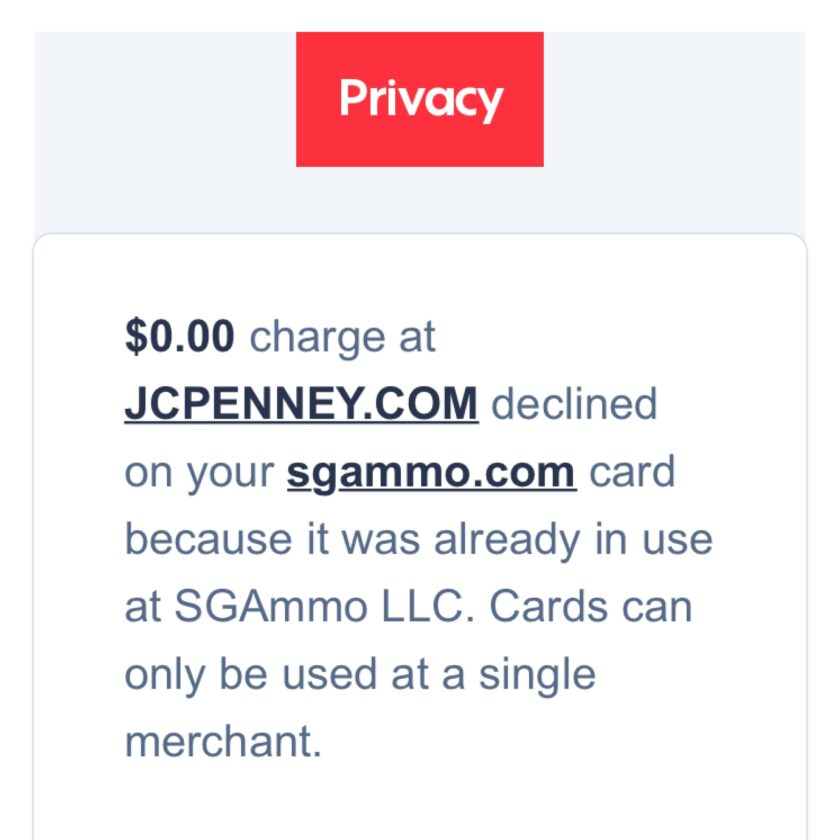
Buying a little bit at a time isn’t that difficult either. It simply means buying more ammo than you shoot. I know a lot of people who will go to the range and buy three boxes of ammo. If they shoot two, they’ll take the third home. The next time they go to the range they’ll bring that box and only buy one for their current visit. That is a missed opportunity. If you shoot two boxes of ammo each time you go to the range, buy three and bring that third one home.
If you only go to the range once a month and do that each time, you will accumulate 600 rounds in just a year’s time. Now think back to the years you’ve been shooting. An extra box for each range trip might equal several thousand rounds. The big benefit here is that you don’t have to spend a fortune up front – just an extra $20 spot every range trip definitely adds up. The downside? That $20 would go much further if applied to a case of ammo.
Regardless of which route you choose, I have a couple further recommendations. First, don’t put yourself in debt to purchase ammo. If you can’t afford a case (or a box) of ammo now, you might have to wait another two weeks before you can. Second, make sure you are paying attention to all of the firearms you are stocking ammo for. That may mean buy a little rifle ammo this month, a little pistol ammo next month, and some shotgun ammo the month after that. Don’t wait until you have 25,000 rounds of 9mm to begin thinking about your rifle.
Storing Your Ammunition Stockpile
Once you have all this precious ammunition, obviously you will want to take care of it. There isn’t a whole lot to this, but there are a few things you want to be aware of. First, ammunition should be stored somewhere dry.
I store ammo in my basement. Even though my basement has never flooded, I recognize the possibility and keep ammunition on shelves and on top of the safe. If you live in an area that is prone to flooding – or have a basement, or store ammo near plumbing or your water heater – it would be a very good idea to keep your ammo up, off the floor. It would also be a good idea to keep an eye on the humidity in the environment where you store your ammo.To combat humidity I keep a dehumidifier (you’ve seen pictures of it in some of my dry practice articles) running at just about all times in my office. This does a pretty decent job of keeping the air nice and dry down there.
Another option for keeping ammo dry is a airtight ammo cans. I don’t do this with bulk ammo because of the sheer number of cans I would need. However, this is a really robust, waterproof, airtight option, and I do have some small-quantities defensive ammo in ammo cans, in the safe. Most of my ammo, though, is just packaged in the boxes it shipped in. If you do put ammo in an ammo can, make sure you are using some silica gel packs to absorb the moisture in the air you are sealing into the can.
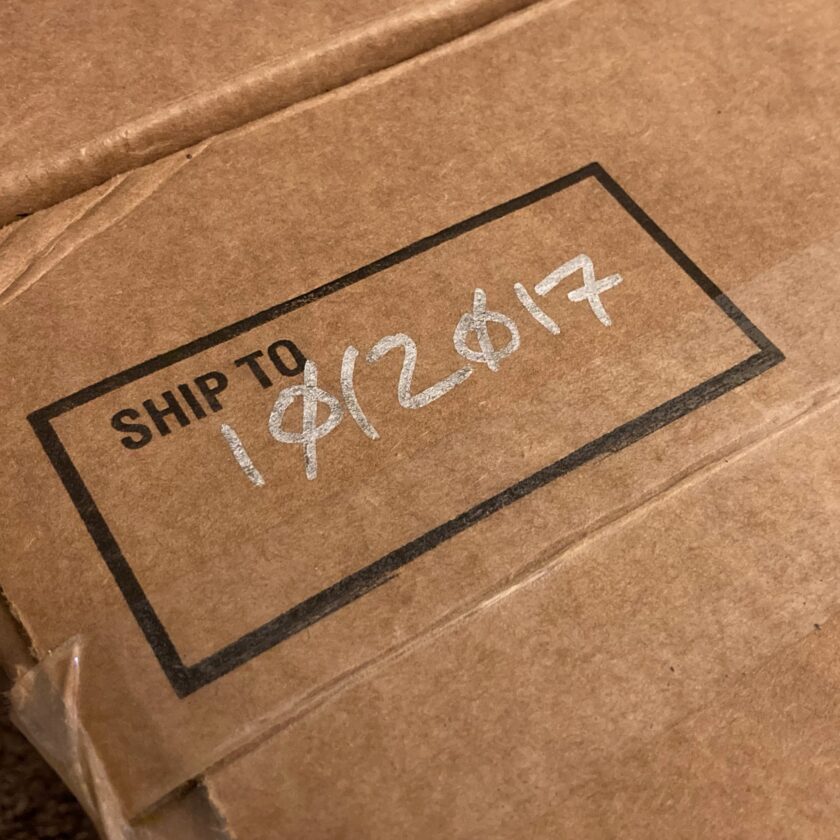
Second, establish a “first in, first out” policy. I rotate ammunition so the oldest stuff is what I shoot first. If I buy a case of 9mm this week, it gets moved to the back of the pile. I then pull out that case of ammo I purchased in 2016 or 2017 and begin shooting that. This ensures that a few cases don’t get shoved to the back and forgotten for years. It ensures the ammunition I do have on hand is as new as it can be. To make this a little bit easier I throw a month/year date on cases of ammo as they come in.
Parting Shot
Sometimes ammunition is really cheap and widely available. We have just experienced almost ten years of the lowest-cost, most widely available ammunition possible. Though you might have to buy a little ammo right now to start your stockpile (and I do recommend you start soon), I generally recommend buying when ammo is cheap. I imagine ammo will be cheap again. Probably not this year, an election year, but maybe next year.
If the sitting President is reelected, most people will completely forget that another election will come along in four more years. They will completely forget that ammunition demand will increase again, and that prices will go up accordingly. They will be reminded only when prices go up and ammo becomes harder to find. . . And they will panic all over and buy ammo at peak prices, getting less ammo for more money. Don’t be that guy. Panic during the cheap times.






1 thought on “Stockpiling Ammunition: A Thorough Approach”
Comments are closed.